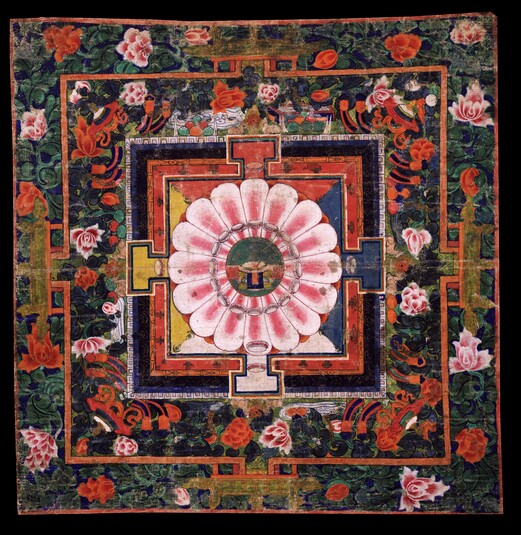
Item: Mandala of Shakyamuni Buddha - with Sixteen Elders (Arhats)
| Origin Location | China |
|---|---|
| Date Range | 1700 - 1799 |
| Lineages | Uncertain |
| Size | 39.37x38.10cm (15.50x15in) |
| Material | Ground Mineral Pigment on Cotton |
| Collection | Rubin Museum of Art |
| Catalogue # | acc.# P1998.2.2 |
Classification: Person
Appearance: Buddha
Gender: Male
Shakyamuni Buddha and the 16 Arhats Mandala (Tibetan: sang gye sha kya tu pa dang ne ten chu drug pa'i kyil khor).
Sanskrit: Buddha Shakyamuni Tibetan: Sang gye sha kya tu pa
Tibetan: Sang gye sha kya tu pa
In this symbol mandala, a mandala without actual figures, Shakyamuni Buddha and the sixteen Arhats are represented by lotus cushions placed on top of a circular sixteen petal pink lotus blossom. Mandalas such as this are not unusual and are often created in sets that accompany the ritual texts required in bestowing the initiation to new meditation practitioners. Sets of mandalas such as this would number from as few as twenty up to several hundred depending on the source text that they accompany. In general, ritual mandalas are made from sand, painted, embroidered or applique textile. For painted mandalas they can depict actual deity figures, symbols, letters or simply the seats beneath the deities as in this mandala.
At the center of the mandala is a small lotus atop a lion supported throne. This symbolizes the historical Buddha Shakyamuni. Starting directly below (in front) and circling clockwise are sixteen small lotus seats for each of the Sixteen Great Arhats. At the four sides of the square enclosure are four doors, 'T' shaped structures, each with an additional lotus seat representing the location of the Four Guardian Kings of the Directions: Vaishravana, Dhritarashtra, Virudhaka and Virupaksha. Below the lotus at the lower front is an additional single lotus seat for the attendant to the Arhats, Upasaka Dharmatala. Another figure commonly associated with the Arhats is the Chinese Patriarch, Hvashang. He is absent from this mandala because the source text that the ritual practice and mandala are based on is derived from the Kashmiri Buddhist tradition which does not include Hvashang.
In Tibetan Buddhism there are two streams of lineage that brought this Shakyamuni and Arhats mandala to Tibet. The fist is attributed to Jowo Atisha in the 11th century and then in a separate lineage to Shakyashri Bhadra of Kashmir, circa 1200. The practice is common to all traditions of Tibetan and Himalayan Buddhism and is regularly performed in morning services in monasteries and temples. Elaborate forms of the ritual practice are done in the spring during the Saga Dawa (Wesak) month which commemorates the Buddhas birth, enlightenment and parinirvana.
Jeff Watt 9-2000 [updated 12-2008]
Exhibition: Mandala, The Perfect Circle (RMA)
Thematic Sets
Mandala: Mandala Main Page
Collection of Rubin Museum of Art: Painting Gallery 7
Shakyamuni Buddha with 16 Arhats
Shakyamuni Buddha: Mandalas
Mandala: Square Format
Shakyamuni Buddha: Mandala (Square Format)
Collection of Rubin Museum of Art: Mandala
Arhat: Shakyamuni & Elders Mandala
Mandala: Symbol Type

